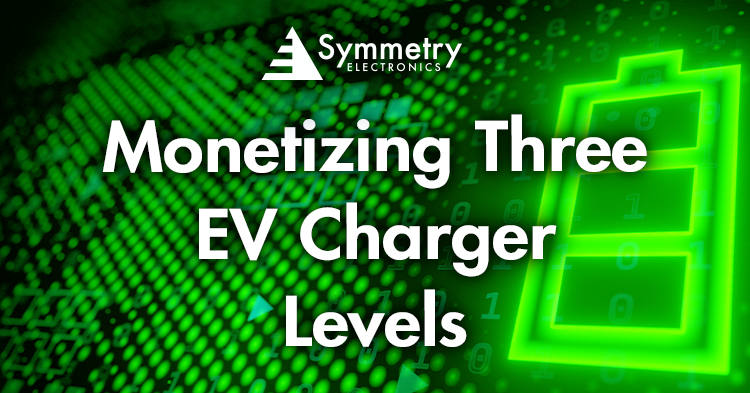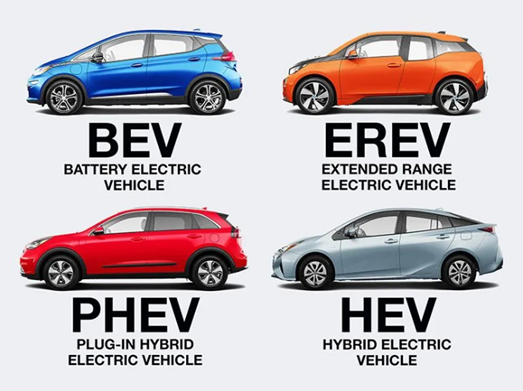- Home
- Symmetry Blog
- Monetizing Three EV Charger Levels
Monetizing Three EV Charger Levels
About Jari Haiston

With the nation targeting a goal of achieving net-zero emissions by 2050, governing bodies, companies, and consumers in the US are actively seeking methods to reduce and prevent the production of greenhouse gas (GHGs) emissions. Fossil-fueled cars and trucks, which currently account for nearly one-fifth of the nation’s GHGs, are poised to become relics of the past as consumers race toward the future of electric vehicles (EVs). In fact, President Biden is laying the groundwork for EV purchases to make up half of all US auto sales by 2030.
While EV sales have climbed by more than 40% each year since 2016, America is still lacking the required charging infrastructure necessary to support the popularity and full integration of EVs. In an effort to prepare, initiatives like the Bipartisan Infrastructure Law (BIL) are being enacted to provide billions of dollars to develop and install sufficient charging infrastructure. Symmetry Electronics has everything developers need to jump on the EV charging bandwagon and design a comprehensive EV charging solution.
Three Levels of EV Charging
Contrary to common belief, EVs aren’t solely intended for consumers. Different classes of electric vehicles (Figure 1) can also be utilized in industrial, manufacturing, and distribution centers. For instance, warehouse developers are witnessing a growing demand for EV chargers to support the in-house adoption of electric vehicles and machinery.

Figure 1: Four types of electric vehicles (EVs).
Source: Current EV
Distribution companies like GE Appliances, a subsidiary of Haier, have introduced EV chargers for their local-range fleet of electric trucks used to transport products between manufacturing facilities and warehouses. However, integrating next-generation EV charger technology in corporate settings presents its own set of challenges related to costs, capabilities, and power requirements. The level of EV charger required is determined by the power needs of electric vehicles or machinery. There are three levels of EV chargers:
- Level 1 is the most accessible and affordable form of EV charging. All EVs come with a cord that can be plugged into a standard 120v household outlet. Charging rates typically average 3-5 miles per hour, making it suitable for vehicles that travel less than 40 miles per day.
- Level 2 charging systems are available at many public charging facilities and run on 240v power. They provide an average charging rate of 25-30 miles per hour.
- Level 3 (DC Fast Charging) stations are typically found in locations like office buildings, shopping malls, and highway rest areas. These stations offer ultra-rapid charging rates, providing 125 miles of range in just 30 minutes of charging.
It's important to note that not all EVs have the same efficiency in terms of miles per gallon electric (MPGe). MPGe depends on factors such as vehicle type, road and weather conditions, and driver habits.
Is More Charging Infrastructure the Only Requirement for Full EV Integration?
Expanding the charging infrastructure is essential for full EV integration, but it's not the sole requirement. Accessibility to additional charging systems must also be considered. Charging an EV at a public station can cost 5-10 times more than charging at a private station. The BIL addresses this issue by not only meeting the public demand for 500,000 new public EV charger installations but also focusing on economically accessible solutions to ensure a sustainable EV future.
Developing Your Own EV Charger
Symmetry Electronics offers the necessary components for developers to design advanced EV charging solutions. For a comprehensive connectivity solution, Nimbelink’s NL-SW-LTE-TC1NAG 4G LET CAT 1 North America embedded modem is ideally suited to deliver reliable cellular connectivity. Supporting GNSS and dual SIMs, the NL-SW-LTE-TC1NAG provides a single SKU for AT&T/Verizon networks, integrated TCP/IP stacks, and is AT&T FirstNet capable.
Digi International’s IX20-00N4 is a feature-rich, compact, and cost-friendly cellular routing platform that is well suited for industrial infrastructure applications. Providing automatic and software-selectable primary and backup WWAN connectivity over multi-carrier cellular LTE, the IX20-00N4 supports dual SIMs and is equipped with built-in, robust device security.
The Kyocera AVX 1002289F0-AA10L0200 LTE cellular embedded antenna is high-performance and based on a flexible substrate for convenient integration. As an enhanced connectivity solution, the 1002289F0-AA10L0200 supports cellular bands for LTE with backward compatibility.

